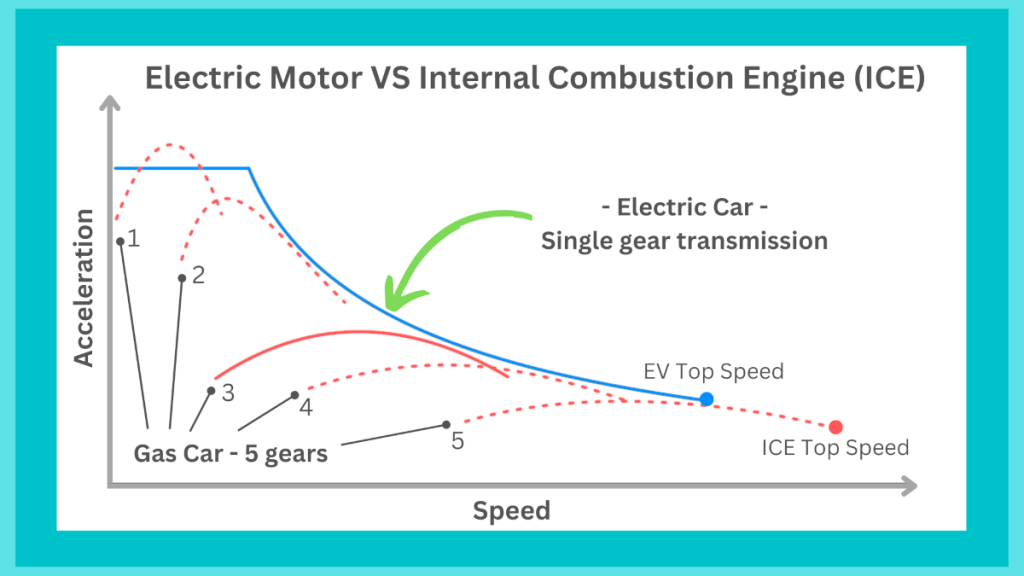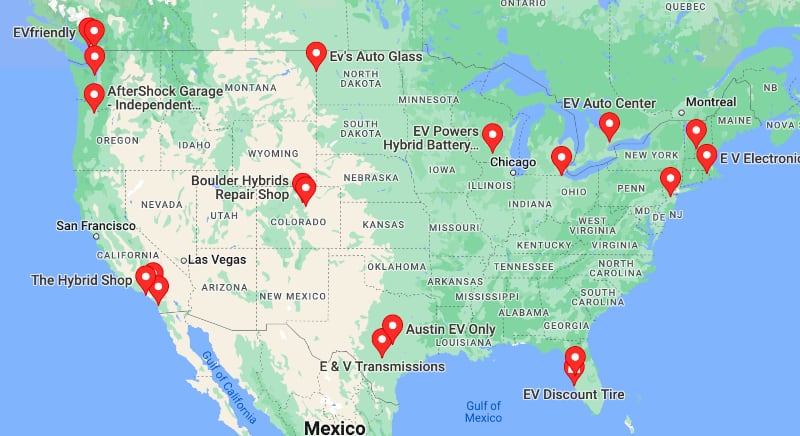Yes, electric cars do have a transmission, however, this is very different compared to the one on traditional gas cars. In fact, the transmission of an electric car typically has only one gear.
Electric cars do not require a traditional transmission system with multiple gears. This is because they don’t have engines and electric motors can operate efficiently at a wide range of speeds.
Why do electric cars only have one gear? (and how it works)

Electric cars only have one gear (single-speed transmission) because electric motors simply don’t need anything more.
There are many nuances in how Tesla cars work, for example, there are several reasons why electric cars like Tesla Model S don’t need multiple gears:
- Electric motors are high revving and remain efficient across a broad rev range. For example, a high-performance EV motor could spin up to 20’000 rpm! This means that they can be geared specifically for the car’s top speed and still work correctly at lower speeds.
- Electric motors produce a great amount of torque even at low RPM. This means that they don’t need multiple gears for the electric car to start moving and then reach the top speed. This feature is especially useful on electric pickup trucks and other heavy-duty vehicles.
- Electric cars have a top speed that is typically lower than gasoline cars. This means that they don’t need the taller gearing that gasoline cars need to reach their top speed.
Let’s explain this in one simple chart!
The chart below shows the acceleration vs speed comparison between an electric car with single speed transmission and a gas car with a 5 gears transmission and ICE. As you can see, the gas car needs multiple gears to be able to start moving and then reach its top speed. On the other hand, an electric car, thanks to the characteristics of electric motors, can do the same on a single gear transmission.

So, there you have it! These are the reasons why electric cars only have one gear. Those are also some of the reasons why, with the evolution of technology, Formula E gradually moved away from having gearboxes with multiple gears.
Now let’s compare those features with the ones of a traditional gas car:
- The internal combustion engine (ICE) needs to reach a certain range of engine rev (usually between 1500 and 6000 revolutions per minute RPM) before generating enough torque to put the car in motion and then accelerate.
- The gas engine generates less torque compared to an electric motor.
- The ICE needs to keep spinning also while idling, that’s why traditional gasoline cars need a clutch, while electric cars don’t. In fact, an electric motor can simply stop and then start spinning again without any issue.
This means that a gasoline car needs different gear ratios to start moving and then to keep increasing its speed. An electric motor instead is much more versatile and simply allows the electric car to go from zero to its top speed on a single gear.
Those characteristics of electric motors are also used by many hybrid cars, which can put the car in motion more efficiently by simply using the high electric motor torque at very low RPMs.
Electric car transmission advantages And Disadvantages
Now you may be asking: what are the pros and cons of an electric car transmission?
Here are the advantages and disadvantages of an electric car gearbox!
Benefits of EV transmission
There are many advantages of an electric car transmission, including:
- Electric car transmissions are much more efficient than traditional gasoline or diesel transmissions. This is because having fewer gears, less energy is wasted due to friction between moving parts.
- Electric car transmissions provide instant torque and power, making them ideal for use in performance electric vehicles.
- Electric car transmissions are much smaller and lighter than traditional transmissions. This helps to reduce the weight of the vehicle and leaves more space available for other uses.
- Electric car transmissions are much quieter than traditional transmissions, improving comfort and making them ideal for use in luxury vehicles.
- Electric car gearboxes require much less maintenance because they have fewer moving parts, less wear, and fewer components. However, keep in mind that some EVs, like the Tesla Model S, require the replacement of the transmission fluid at regular intervals.
- Cheaper: the transmission of electric cars is cheaper than that of gas cars. This is not bad considering that replacing a transmission on a gasoline car costs on average $5’000 USD!
- Eco-friendly: the EV transmission is also more sustainable because:
- It requires fewer materials and works to make it.
- It has less wear, so it is likely to last longer.
- It is much more simple, so it will be easier to repair it.
Cons of EV transmission
The main disadvantage of the electric car transmission is that the gear ratio is fixed and can’t be changed.
This means that while having better acceleration, the top speed of electric cars is usually lower compared to gas cars.
Maintenance needed for an EV Transmission
The main maintenance needed for an electric car gearbox is to replace the transmission fluid at regular intervals.
This is one of the very rare oil changes required by electric cars, which instead don’t use any engine oil. This will however vary based on your car model, for example, Teslas usually don’t need oil changes at all.
Even if electric cars tend to have less wear than conventional vehicles, in some rare cases it may become necessary to replace the gearbox. However, the cost will be much lower than what you would pay to replace a conventional transmission.
Where to service an EV transmission?
If you need to service your electric car transmission, the best way is to find an EV repair and servicing workshop in your area. Click the button below to search for it!
How much is a transmission for an electric car?
There is no one-size-fits-all answer to this question, as the cost of a transmission for an electric car will vary depending on the make and model of the car. However, as a general rule, you can expect to pay between $700 and $1,000 for a transmission rebuild of an electric car.
Do any electric cars have manual transmissions?
There are a few electric cars that come with manual transmissions, but they are relatively old and rare. Most electric cars have transmissions with a single gear, which are more efficient and easier to use because they don’t require shifting.
The main reason for this is that electric cars have instant torque, which means they can accelerate very quickly. This can make manual transmissions not necessary and also difficult to eventually use.
Are there electric cars with multiple gears?
Yes, there are electric cars with multiple gears. These cars typically have two (like the Porsche Tycan) or three gears, which helps to make them more efficient and smoother to drive. The extra gears also help to improve the car’s acceleration.
However, having multiple gears add complexity, driving up maintenance costs and the weight of the vehicle.
Does a Tesla electric car have a transmission?
Yes, electric cars have transmissions, and Tesla’s are no different. The transmission in a Tesla electric car is a single speed fixed gear (ie. it has only one gear).
The gearbox ratio of a Tesla electric car is usually about 9:1.
Conclusion
Electric cars as well as hybrid vehicles are becoming more and more popular as people become more conscious about the environmental sustainability benefits. Here’s an article about the pros and cons of electric cars for the environment as there is much more to EVs than just not requiring gas to run.
Overall, electric cars are much simpler than gas cars, which is one of the reasons they are so efficient. They don’t have many of the moving parts that gas cars have, such as a transmission.
They are cheaper to operate and maintain than gas cars, and they emit no pollutants. Electric cars, like solar boats, are the wave of the future and will help to reduce our reliance on fossil fuels and improve air quality.
Moreover, electric cars can also easily recover kinetic energy and turn it into electricity while decelerating. This is easily done thanks to regenerative braking, allowing electric cars to partially charge themselves back (even without needing an alternator) and be more efficient.
Most electric cars only have one gear, which makes them simpler and easier to repair. Even though they don’t have a multi-gear transmission, electric cars are still able to accelerate quickly and reach high speeds thanks to the efficiency of their electric motors!
You may also be interested in reading:



